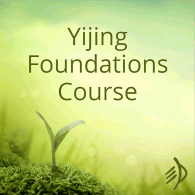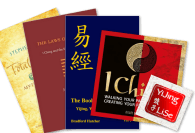The next three hexagrams with trigram li outside are 30, Clarity (doubled li, inside and out), 35, Advancing (fire over the earth) and 38, Opposing (fire above the lake). Each one has a different kind of trigram interaction, but the outer light always seems to be expanding awareness: spreading the light of culture, revealing the opportunities in earth, and illuminating relationship and difference.
Hexagram 30, Clarity
Hexagram 30, of course, has li outside and inside, and so I wrote about it before – Light inside: hexagrams 13, 22 and 30 – and don’t have much to add.
‘Doubled light gives rise to Clarity.
Great People with continuous light illuminate the four regions.’
Light here is spreading from inside to outside: the great people’s understanding, enlightening others. It makes a good contrast with the movement of water in Hexagram 29, the Repeating Chasms –
‘Waters flow on and reach the end: Repeating Chasms.
A noble one, consistent in character and action, teaches things by repeating.’
Water flows in a single consistent direction; light spreads in all directions at once. The insight of the great people grows into a web of connections that gives rise to culture – and remember that the culture hero Fuxi, the same one who discovered the trigrams themselves, was inspired by Hexagram 30 to invent nets. Writing about this last year, I suggested ‘that he’s the inventor of a net of concepts that captures the whole world and creates Clarity through its patterns.’
Hexagram 35, Advancing
Here, li is above kun: the light is shining down on the earth. It’s daytime – ‘Advancing means daylight’, says the Zagua – when the sunlight acts on the earth, makes things grow, and defines the time we have for action. (Even if you imagine li here as sun, moon and stars, this is still light relative to earth – a 24 hour cycle.) It probably isn’t coincidence that the Oracle text says 畫日, ‘in the course of a day’ (or ‘by the light of a day’, in Bradford Hatcher’s translation) – and the bottom part of the hexagram name was sometimes written as the sun.
To grasp this, we need to imagine a world without electric light – no artificial prolongation of working hours – so that the sun’s light is a precious gift, not to be wasted. Confucius was most unimpressed by a student who was caught napping during daylight hours; Prince Kang is the exact opposite of this, making the very most of his gifts and his time. Seize the day.
So to begin with, the sun is casting light on the inner trigram – showing what can be done, illuminating our capacities and gifts. The other way I’ve noticed li-as-outer-trigram showing up is as a light sustained – fuelled – by the inner trigram. In Hexagram 35, the Image shifts our point of view to see from this perspective:
‘Light comes forth over the earth. Advancing
The noble one’s own light shines in her character.’
Or in other translations, the noble one…
- ‘naturally radiates clarity of character’ (Bradford Hatcher)
- ‘himself brightens his bright virtue’ (Wilhelm/Baynes)
- ‘himself shines with bright powers’ (Rutt)
- ‘illuminates himself with bright virtue’ (Lynn)
It creates an interesting shift in perspective (as the Image often does): the king gives horses to Prince Kang as the sun gives its light to the earth; the sun rises from the earth, and the noble one’s light emerges from their own nature. I’m imagining this as the raw, unshaped clay of character developed into ‘bright virtue’ and shining out.
Hexagram 38, Opposing
Light engenders light (in Hexagram 30); light shines out freely and creates opportunity (in Hexagram 35). But what if the light doesn’t meet a response, or at least, not one at the same angle? When light shines over the lake, in Hexagram 38, Opposing, the water will bend the light, or fracture it into dazzlement. The eyes squint; those other people see differently. It’s pretty clear that fire and water don’t mix: the inner trigram isn’t ‘fuelling’ the outer fire this time, though it might change and multiply our experience of it.
These trigrams probably get mentioned more often than most, because Wilhelm gives them a mention in his Book I:
‘This hexagram is composed of the trigram Li above, i.e., flame, which burns upward, and Tui below, ie.. the lake, which seeps downward. These two movements are in direct contrast. Furthermore, Li is the second daughter and Tui the youngest daughter, and although they live in the same house they belong to different men; hence their wills are not the same but are divergently directed.’
Wilhelm is drawing on the Tuanzhuan, the commentary on the Oracle, which happily doesn’t explain the divergence in terms of being property:
‘The fire moves, but (only) upwards
The lake moves, but (only) downwards.
Two women dwell together,
(But) their intentions do not function as one.’
Bradford’s translation
Literally, the two women live in harmony – the word used is tong 同, which we know from Hexagram 13 People in Harmony, and also from 38’s Image – but their wills (/aspirations / intentions) do not move in harmony.
Unusually for the Tuanzhuan, this is often recognisable in reading experiences with the hexagram. There’s an inner division: two people living in your head, who want to move in opposite directions. Sometimes the divergence is between emotional depths and clear awareness.
However, the commentary doesn’t stop with the two sisters. It continues…
‘Heaven and earth are in opposition, but their affairs are in harmony.
Male and female are in opposition, but their intentions are joined.
The ten thousand things are in opposition, but their affairs are related.’
That’s ‘affairs’ as in the Oracle itself –
‘Opposing.
Small affairs, good fortune.’
So the opposing elements here do more than just move apart. As the Image says,
‘Fire above, lake below. Opposing.
A noble one is in harmony and yet different.’
‘In harmony’ is tong as in Hexagram 13, People in Harmony. And ‘different’, 異 yi, is a weird and wonderful character that you can see here in its earliest forms, thanks to Richard Sears: https://hanziyuan.net/#%E7%95%B0 . My dictionary suggests prosaically that it meant someone carrying a container on their head – but what it shows is someone with a container, or something, for a head. It means different, other, extraordinary, strange, to divide, to separate, a foreigner.
I used to translate this as ‘the noble one both harmonises and separates,’ but I think I missed the point: this is about how you yourself relate to other people, making friends but without having to be the same. I’d like to think of it as permission to be the weird one.
Like the Image of Hexagram 14, this is not laden with direct references to its trigrams’ actions; it just shows the whole picture of the two together. (Though you could say that lake harmonises and fire differentiates.) Perhaps the idea is that the light illuminates the inner life, the heart – even if that creates distortions – and all the conversation and intermingling that goes on within the lake’s currents. You can empathise with other people and still see things differently.
So… elements that diverge can still be in relationship and work in harmony; indeed, it starts to look as though all those little differences are what create relationship, interaction and good fortune in ‘small affairs’. And in the end – when we reach line 6 – if the others are sufficiently different (because you can’t marry inside your own clan), we could join our people with theirs in marriage:
‘Opposed, alone.
Seeing pigs covered in muck,
The chariot loaded with devils.
At first drawing the bow,
Then relaxing the bow.
Not robbers at all, but matrimonial allies.
Going on meets the rain, and so there is good fortune.’
It’s going to be quite some task, though, to get past the automatic perception that other = enemy.










love this post; especially the thorough review of 38. in the Human Design System my unconscious sun is 38.1 and unconscious mercury is 38.3.2 both in Capricorn. both my solar Plexus (emotions) and awareness center are defined! I’ve lived with this seeming dichotomy and tension between emotions..awareness..feeling ‘different’ in family and friends social circles. this is the best description I’ve ever read of 38! thankyou!!
In terms of this reading as a personal response, it quite interestingly indicates that we can work together even when we have a divergence of opinion, or worse, different strategies and goals. Generally people want to work together. We do have differences though that lead to conflict. Often though, and this is apparent in Hexagram 13 as well, when we find another with an opposing point of view, or working at odds with us, we see them as something evil or at least someone that is contentious with us. Often we don’t look beyond the obvious, not realizing that another has no obligation to be on our side, and that there is a way to settle the difference. This keeps us apart from one another, not just on an individual level but on a societal level, and on an international level. We must find terms with which we can work together.
It is a mistake however, to think that if we negotiate honestly, everyone else is not necessarily going to do the same thing. This is why countries must have militaries. We cannot negotiate with everybody.
We all have our delusions and our rose colored glasses. And until we take them off we cannot see clearly the way to peace. But even if we do take them off, it doesn’t necessary mean the other person will take theirs off. Therefore we need vigilance, and we need to remember that our enemy is often just a mirror image of ourselves. And when we see the enemy in a truer light, that enemy is no longer an enemy. Still… We must be prepared, because just because we have taken the high road and understand our projections, (sitting on a high wall, spying out our enemies, Hex 13), does necessarily mean the enemy has taken the same steps.
But on an individual level, the possibility for a recollection is greater than it is on a societal or international level.